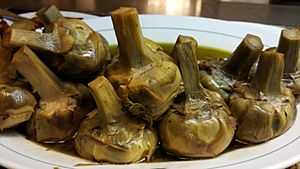Roman cuisine facts for kids
Roman cuisine comes from the city of Rome in Italy. It uses fresh, seasonal foods that are prepared simply. These foods come from the Roman Campagna area around Rome.
Some common ingredients are peas, artichokes, and fava beans. People also eat shellfish, young lamb, and goat. Popular cheeses include Pecorino Romano and ricotta.
Olive oil is mostly used on raw vegetables. For frying, people often use strutto (pork lard) or fat from prosciutto. Rome's most popular sweets are small pastries called pasticcini, gelato (ice cream), and handmade chocolates.
Some special dishes are eaten on certain days of the week. For example, gnocchi is often eaten on Thursdays. Baccalà (salted cod) is popular on Fridays. And trippa is a common dish for Saturdays.
Contents
History of Roman Food

Rome's food has changed a lot over many centuries. In Ancient Rome, food was mostly based on grains, cheeses, beans, and fruit. As the Roman Empire grew, Romans learned about new cooking styles from other places.
Later, during the Italian Renaissance, Rome became famous for its fancy cooking. Some of the best chefs worked for the popes. One famous chef was Bartolomeo Scappi. He worked for Pope Pius IV in the Vatican in the 1500s.
Scappi wrote a famous cookbook called Opera dell'arte del cucinare in 1570. It had about 1000 recipes and showed cooking tools. It even had the first known picture of a fork!
Roman food, and all Italian food, changed a lot when new crops arrived from the Americas. The most important new food was the tomato, brought by the Spanish.
Traditional Roman Dishes
The Testaccio area in Rome was once known as the city's "belly." This is because it was where animals were prepared for food. Butchers, called vaccinari, lived there.
Many traditional Roman foods came from this area. These often included parts of animals that were not usually eaten, like pig's trotters or brains. These were carefully cooked and spiced.
One very popular dish is coda alla vaccinara. This is oxtail cooked in the butchers' style. You can still find it on menus in most Roman restaurants. Lamb is also very popular, often roasted with spices.
Roman cuisine also has a strong Jewish influence. Many Jewish people lived in the city for centuries. Some traditional dishes from the Jewish quarter are over 400 years old. Examples include carciofi alla giudia (Jewish-style artichokes) and Jewish courgettes.
Pasta in Rome
Pasta is a very important part of Roman cooking. There are many famous Roman pasta dishes.
Some popular ones include:
- Cacio e pepe: This means "cheese and pepper." It's a simple pasta with black pepper and grated Pecorino Romano cheese.
- Gricia: This sauce is made with guanciale (cured pork cheek) and hard cheese, usually Pecorino Romano.
- Carbonara: This is like gricia but with added egg yolks.
- Amatriciana: This is like gricia but with added tomato.
You might have heard of Alfredo sauce. It was invented in Rome by a chef named Alfredo. But it is not considered a traditional Roman dish and is not very common in Rome itself.
Rome's most common pasta shape is spaghetti. However, there are many other shapes too.
Roman Drinks
Rome is known for its white wine. Some of the best local white wines come from areas like Frascati and Castelli Romani.
Other Roman Foods
Roman cuisine includes many other tasty dishes. There are also several desserts and sweets. Many of these are made with ricotta cheese. A special Roman treat is the grattachecca, which is like shaved ice with fruit syrup.
Popular Roman Dishes
- Abbacchio alla cacciatora – Lamb chops cooked in olive oil, white wine, and vinegar. They are spiced with garlic, sage, anchovies, and rosemary.
- Bucatini all'amatriciana – A pasta dish with tomato sauce, guanciale, and grated Pecorino Romano cheese.
- Bruschetta – A popular appetizer. It comes from a Roman word meaning "lightly burnt bread." It is usually rubbed with garlic and topped with olive oil and tomatoes.
- Cacio e pepe – A pasta dish with a sauce made from black pepper and grated Pecorino Romano cheese.
- Carciofi alla romana – Whole artichokes filled with minced garlic and parsley, cooked in olive oil.
- Carciofi alla giudia – Jewish-style artichokes. These are whole artichokes deep-fried in olive oil.
- Coda alla vaccinara – Oxtail stew. It can be cooked with tomato sauce, chocolate, celery, and spices.
- Crostata di ricotta – A tart made with ricotta cheese. Sometimes it has lemon or orange flavor and Marsala wine.
- Fiori di zucca – Zucchini flowers filled with mozzarella and anchovies, then battered and deep-fried.
- Pasta alla gricia – A pasta dish with a sauce made from guanciale, black pepper, and grated Pecorino Romano cheese.
- Penne all'arrabbiata – A pasta dish with a spicy sauce made from garlic, tomatoes, and dried red chili peppers, cooked in olive oil.
- Rigatoni con la pajata – A pasta dish with a sauce made from a special part of a young calf's intestines and Pecorino Romano cheese.
- Saltimbocca alla Romana – Roman-style veal. It has prosciutto crudo (cured ham), sage, white wine, and butter. "Saltimbocca" means "jumps in the mouth."
- Scaloppine alla romana – Veal cooked quickly with fresh baby artichokes.
- Spaghetti alla carbonara – A pasta dish with a sauce made from egg yolks, guanciale, black pepper, and grated Pecorino Romano cheese.
- Supplì – Fried rice croquettes. They can be filled with beef ragout and mozzarella, or chicken giblets and other meats.
- Trippa alla romana – Tripe (animal stomach) cooked with tomato sauce, herbs, chili pepper, and vegetables. It is topped with Pecorino Romano cheese.


